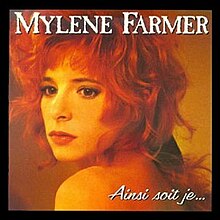Ainsi soit je... (song)
| "Ainsi soit je..." | ||||
|---|---|---|---|---|
 |
||||
| Single by Mylène Farmer | ||||
| from the album Ainsi soit je... | ||||
| B-side | Remixes "Et Tournoie" (live) (1997 release) |
|||
| Released | 4 April 1988 | |||
| Format |
CD maxi, 7" single, 7" maxi, VHS (1988), CD single (1997), digital download (since 2005) |
|||
| Recorded | 1988 | |||
| Genre | Synthpop, baroque pop | |||
| Length |
4:30 (single version) 6:22 (album version) 4:39 (live single version) |
|||
| Label | Polydor | |||
| Songwriter(s) | Lyrics: Mylène Farmer Music: Laurent Boutonnat |
|||
| Producer(s) | Laurent Boutonnat | |||
| Mylène Farmer singles chronology | ||||
|
||||
|
||||
| Alternative cover | ||||

CD single of the live version, release in 1997, nine years after the original release
|
||||
| Ainsi soit je... track listing | ||||
|
||||
"Ainsi soit je..." (English: "So Be I...") is a 1988 song recorded by the French artist Mylène Farmer. The song was released as a single twice: as the second single from her second studio album Ainsi soit je... on 4 April 1988, and as the second single in a live version from her second live album Live à Bercy on 20 August 1997. Both versions achieved a relative success on the charts, failing twice to reach the top ten in France.
After the huge success of "Sans contrefaçon", Boutonnat and Farmer decided to release as a new single the title track "Ainsi soit je...", just one month before the album release. It was the first ballad of the singer. The cover of the single, which was created by Farmer's friend, Elsa Trillat, is almost identical to the album's one, but without the puppet which featured in the video "Sans contrefaçon". The single was released under the traditional formats (vinyls) but also CD maxi and, for the first time, a CD video. The single was also released in Japan, but about two years after the Francophone countries.
As for all her songs since "Tristana", Farmer wrote the lyrics. However, the first words of the couplets "bulle de chagrin, boule d'incertitude" were written in the 1970s by Marie, a singer who had died not long before and unknown to the general public. In this way, Farmer paid tribute to her. According to manager Bertrand Le Page, the song was also inspired by a song entitled "Avant que le monde explose, je veux mourir", which passed unnoticed and which contained in its chorus the words "Ainsi soit-il, ainsi soit-elle".
The song's title refers to the formula which ends Christian prayers ('Amen' i. e. 'Ainsi soit-il' or 'So be it' in English), but here it is spelled 'Ainsi soit je...', instead of 'Ainsi sois-je', showing that the 'Je' (or 'I' in English) is personified. French journalist Benoît Cachin stated that in this song, Farmer "reveals her loneliness, her pain of living and her great lucidity", and deals with the theme of existentialism, which was also present in "À quoi je sers...". This suggests that "the singer's single religion is despair, sadness and great lucidity on the future". She speaks to someone to warn him against her own solitude. The same semantic field is used as in "Regrets": cold, winter, time. According to author Erwan Chuberre, the notes are high, giving thus a "nagging nostalgia" to the song, and the music is like a nocturne by Frédéric Chopin. As in "Rêver" and "Redonne-moi", some lyrics are sung in the high notes to express sadness.
...
Wikipedia
